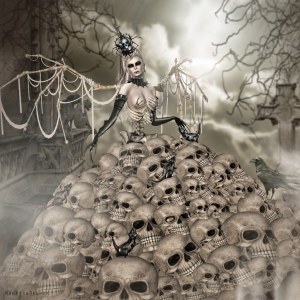 Suppose we have a society where magic that interacts with death and the undead is a normal sort of thing. Necromancy is not evil, just another type of magic. Probably the undead, at least the ones that need life force to survive and can think for themselves, are still bad news. Zombies, however, are just a form of labor that needs a lot less wages and shelter than living workers. This situation can give you a city or a realm for your players to be shocked and confused by. Not only can they get in trouble for dusting the zombie road-repair crew, but if one of them is a black necromancer he will suddenly find himself in trouble for violating city bylaws, licensing requirements, and safety regulations. There is lots of room for comedy here.
Suppose we have a society where magic that interacts with death and the undead is a normal sort of thing. Necromancy is not evil, just another type of magic. Probably the undead, at least the ones that need life force to survive and can think for themselves, are still bad news. Zombies, however, are just a form of labor that needs a lot less wages and shelter than living workers. This situation can give you a city or a realm for your players to be shocked and confused by. Not only can they get in trouble for dusting the zombie road-repair crew, but if one of them is a black necromancer he will suddenly find himself in trouble for violating city bylaws, licensing requirements, and safety regulations. There is lots of room for comedy here.

Once we have the basic idea of a society in which necromancer is another trade, we need to define the parameters of what is, and is not, allowed. Zombies are more-or-less mindless and so fill rolls in basic labor or cannon-fodder. If there is a bridge that is in bad shape you check it by sending zombies over it. Probably there are grades of zombies from fresh-and-strong to almost-used-up. There is probably a market where you can buy or order undead laborers. Freaky, but parallel to standard institutions — zombies may replace slaves because they are easier to control, or “kill the slave and animate him” may be the ultimate punishment for being uppity.
What is in gray necromancy?

There are a number of spells that might fit into a grey necromancer’s spell book, many of which a black necromancer might not even think of. Here are a few suggestions.
- A spell that lets the caster explain a fairly complex job to a magical construct. This construct clings to the mindless undead worker and breaks the job down into a series of orders that the idiot automaton can follow. This is an instructions to zombie compiler spell.
- A ritual, performed as part of or embedded in the animation ritual that imposes a code of behavior on the animated dead produced. Think Asimov’s three laws of robotics as a starting point, but feel free to get creative.
- A direct animation spell. A living character sentenced to useful death is transformed from living to animated dead. Since the character’s spirit (and skills and knowledge) are right there, they can be bound into the animated dead. Why bother? Spells that only affect the undead now affect the new version of the character, plus they stop needing sleep and shelter and can now eat much cheaper food. In particular, this transformation gives you all sorts of options for keeping a useful subordinate under control.
- Power ups for animated dead. Faster, stronger, able to follow more complex instructions, enhanced senses, or even less disgusting appearance. This is another place where there is a lot of room for creativity.
- A seance ritual for seeking advice and knowledge from the departed. This fits into other types of magic as well, but it fits well in gray necromancy.
- An ancestor possession ritual. This is a long ceremony that permits the spirit of a person’s ancestor to share or take over their body to bring them back. This can be in response to a crisis or it may be long term. The incompetent prince becomes king and he is so much like the old king… This ritual could be anything from a standard practice in a crisis to a dark secret.
- Transfer healing — a living person can be used as an energy source for healing. You just transfer your wounds or infirmities to the donor. Victim. Prisoner. Whatever. This might heal living characters, the undead, or both.
- Body swapping: the grey necromancer can move spirits between bodies, even put competent warriors in charge of amped-up zombie bodies or just steal a younger body for himself.
- Mummification to preserve a useful character in an undead state with knowledge and skills intact.
- Grey necromancy may contain the ritual to make the necromancer himself immortal and undead, essentially becoming a lich.
- Deanimation, light that damages only the dead, and other outbreak control spells, possibly area effect.
- Making sage skulls by binding a character’s memory and intellect into their well-cleaned and decorated skull.
Gray necromancy in practice

If you decide to go with a scenario where some realm or world has gray necromancy, you need to decide how important it is. At one extreme, it might be a tolerated but frowned upon eccentricity with the undead relegated to cleaning the sewers and removing horse-shit from the streets very early in the morning. At the other end, it might be that most of the characters in the society are undead, akin to Thay in the Forgotten Realms. Life is reserved for rural rustics that farm both food and raw materials for making zombie laborers and the younger members of the nobility that have to stay alive to make more nobility.
This latter sort of extreme undeath society might have special parties to celebrate becoming undead. After you have your third child, you are permitted to become an immortal undead. Dying before you are transformed would become a lamented tragedy. Such a society might raid for warm bodies to kill in order to augment their labor force. This version of a society, dominated by the outcomes of gray necromancy, becomes a wonderful villain or stock enemy.

Probably the most fun you could have is to let your players wander into an area where there is some tolerated gray necromancy. Zombies clean the sewers is a good level. Let them blunder into the situation and deal with it badly. The phase “you are fined three gold per zombie you killed” has a nice, humorous ring to it. There are many variations and origins for a society with some degree of gray necromancy — find the one most amusing to your players.
This is Dan of Dan and Andrew’s Game Place. Let me know what you think about this post in the comments. If you get ideas from this post, give us a pointer!

One thought on “Gray Necromancers”